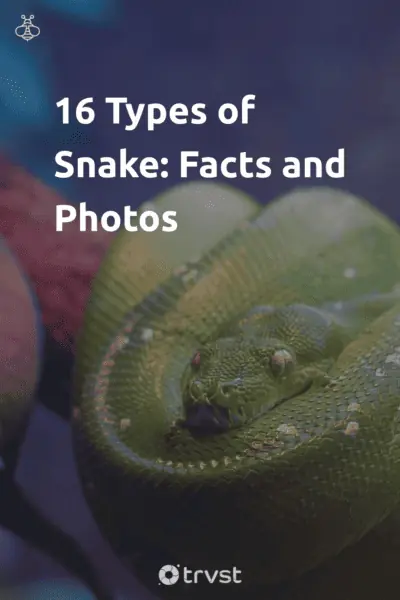17 Types of Snake: Facts and Photos
There are around 3,900 types of snakes to explore. They are vital to global biodiversity with unique characteristics, diverse habitats, and peculiar diets.
Some are terrestrial, and others live in the sea. Some are venomous, while others rely on strength. This article provides a comprehensive guide to the various types of snakes, which will undoubtedly interest novice herpetologists and nature enthusiasts.
Related read: Snake Facts.
17 Types of Snakes You Should Know
Quick links to the different types of snakes:
1. Anaconda (Eunectes)
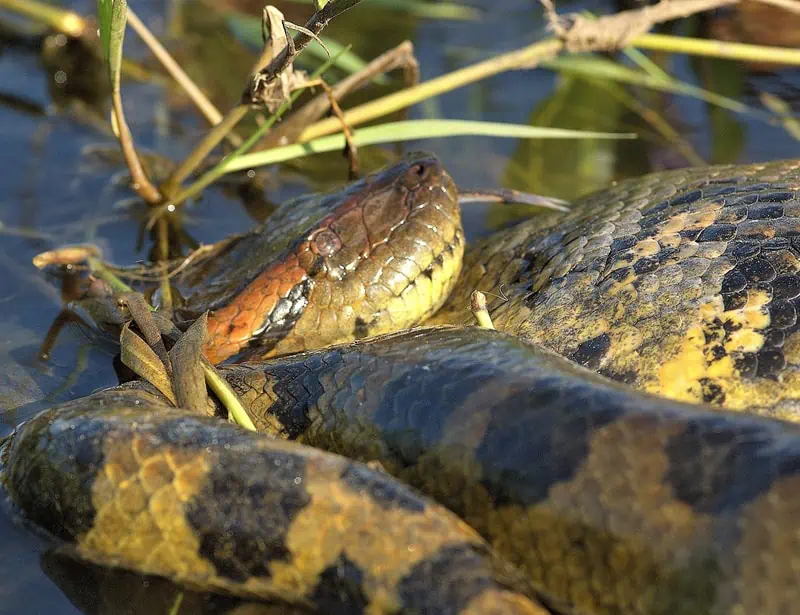
The dense jungles of South America have lush vegetation, bursting rivers, and marshlands. Within their depths live hulking creatures such as the Anaconda, one of the world's longest snakes (the green Anaconda is the longest).
The Anaconda can remain submerged for up to ten minutes and patiently wait for its prey to come close.
Rather than expending energy, the Anaconda prefers to wait and ambush fish, birds, tapirs, and wild pigs, and it can go without food for months to a year due to its slow metabolism.
When it does eat, it constricts its prey’s body to kill it and aid digestion.
Despite their intimidating appearance, anacondas prefer to avoid confrontation unless provoked.
2. Ball Python (Python regius)
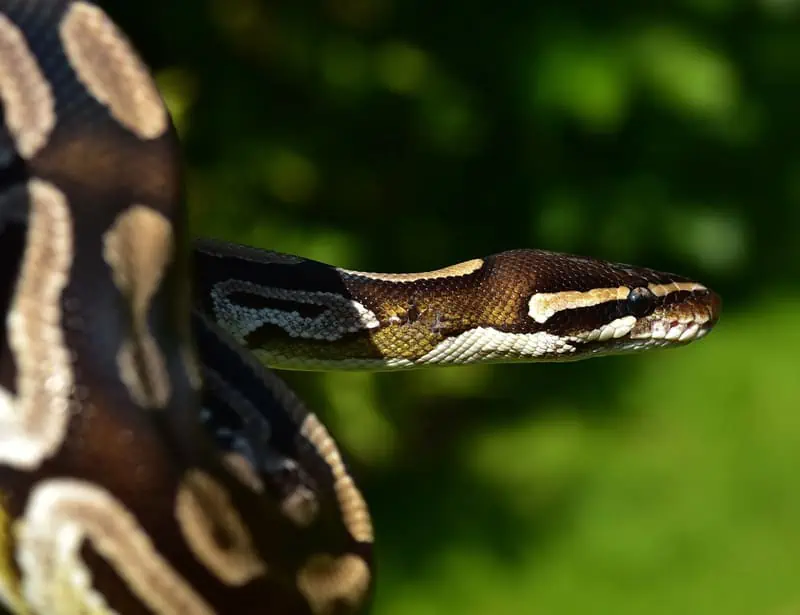
The Ball Python lives in sub-Saharan Africa's grasslands, savannas, and lightly wooded areas. Despite its name, these African pythons grow to a modest length of 3-5 feet, with females generally larger than males.
This type of snake uses its constricting ability to overpower prey despite its smaller size. Its name comes from its defense mechanism of coiling itself into a tight ball, protecting its head at the center.
During twilight hours in Africa, the Ball Python emerges and becomes active, hunting small mammals and birds using their heat-sensitive pits along their lip-line to detect prey.
Female Ball Pythons protect their 3-11 egg clutch by coiling around them1, generating heat through muscular contractions until they hatch.
Read more: Python Facts, Types of Pythons.
3. Black Mamba (Dendroaspis polylepis)
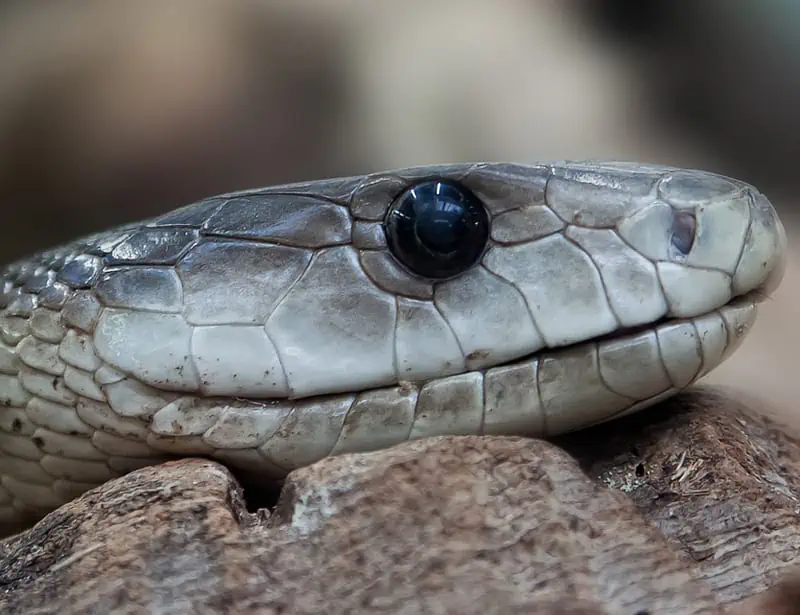
Even with its name, the snake does not have black scales. Its coloration ranges from brown to olive, with a lighter underbelly providing contrast.
The term "black" only applies to the dark color of the snake's mouth, which it exposes when it feels threatened.
Moreover, the Black Mamba lives in sub-Saharan Africa and can thrive in various habitats such as savannas, woodlands, rocky slopes, and dense forests.
These types of snakes are also Africa's longest venomous snakes and the world’s second-longest, reaching up to 14 feet long.
Likewise, it can move at 12.5 miles per hour; its speed and venom make it a skilled predator that primarily feeds on small mammals and birds.
4. Boa Constrictor (Boa constrictor)
Boa Constrictors are massive, with some specimens growing up to 13 feet long. They live in Central and South America, and their colors range from brown and grey to cream.
This famous snake species lives in arid deserts, dense forests, and savannas. To identify them, they have a pattern of saddles and bands that help them blend into their surroundings.
At night, they become relentless hunters, constricting and suffocating their prey. Their diet comprises small to medium mammals and various birds; their slow metabolism helps them survive between meals.
Boa Constrictors give birth to 60 live younglings at a time, a deviation from the reptilian norm of laying eggs.
5. Burmese Python (Python bivittatus)
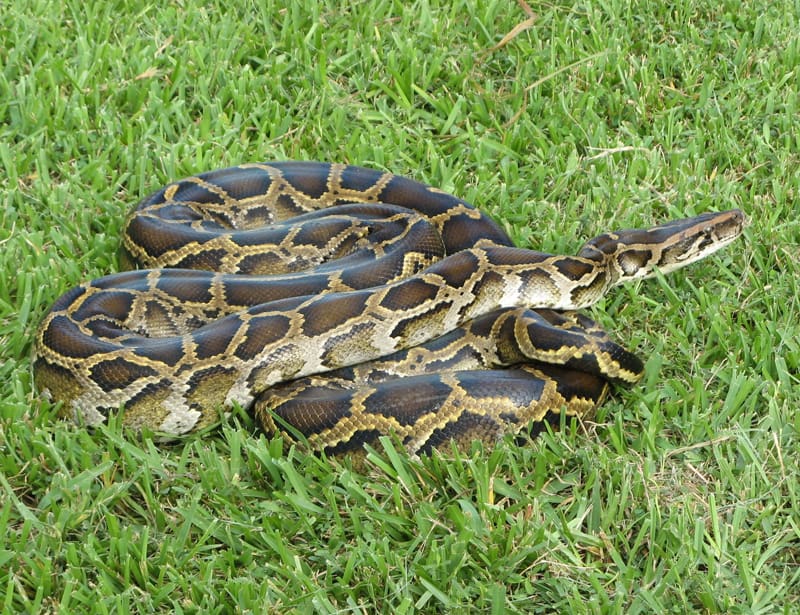
The Burmese Python lives in the swamplands and forests of Southeast Asia. It is one of the largest snakes in the world. Its skin is characterized by a mosaic of browns with dark blotches, bordered by cream or gold.
As a predator, this snake preys on small mammals and birds, but it has also been known to tackle larger animals such as goats or pigs.
Its hunting technique involves seizing the prey with its sharp rear teeth and coiling its muscular body around it to suffocate it2.
In addition to its impressive hunting skills, the Burmese Python can remain submerged for up to 30 minutes before emerging for a quick breath.
During the day, this species stays hidden in a cozy and dim environment, only emerging at night.
Curiously, pythons have vestigial limbs called anal spurs, unlike other modern snakes. They are also one of the very few snakes that incubate their eggs.
6. Bushmaster (Lachesis)
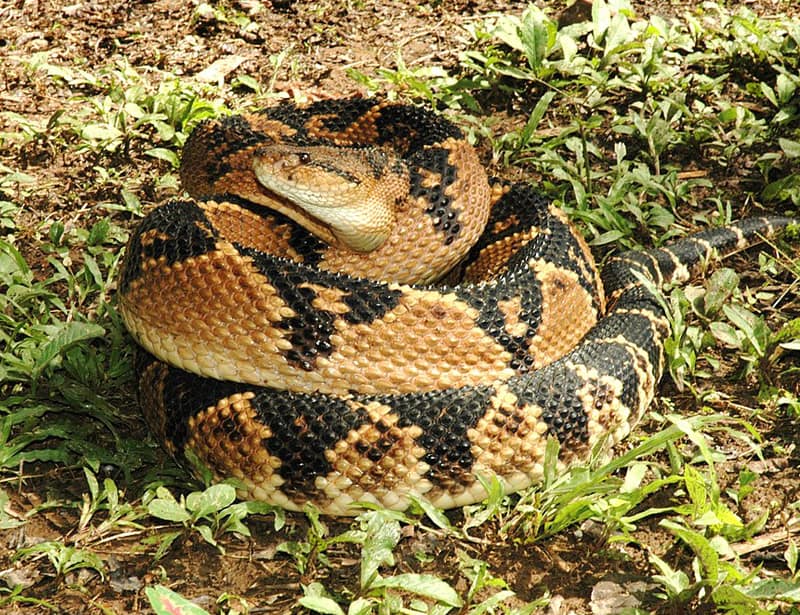
The Bushmaster is a venomous snake living in the rainforests of Central and South America. It is one of the world’s longest snakes, with some individuals measuring over 12 feet, snaking across the dense undergrowth of the rainforest.
The Bushmaster has a scalation pattern ranging from 23 to 37 rows of keeled dorsal scales wrapped around it. These scales allow the snake to blend seamlessly into its forest environment.
As one of the world's pit vipers, the Bushmaster possesses heat-sensing pits between its eyes and nostrils, allowing the nocturnal snake to track prey in the dark.
Small mammals and birds comprise the Bushmaster's primary diet, and the snake employs a surprise attack strategy. It lays motionless in wait before striking with unexpected speed.
The Bushmaster also uses a unique hunting gimmick called "caudal luring," where it wriggles its tail to imitate a worm, drawing unsuspecting prey closer.
The venom of this type of snake is a potent blend of neurotoxins and hemotoxins that can kill humans. However, it prefers to save its venom for prey, resorting to aggression toward humans only when it feels threatened.
7. Corn Snake (Pantherophis guttatus)
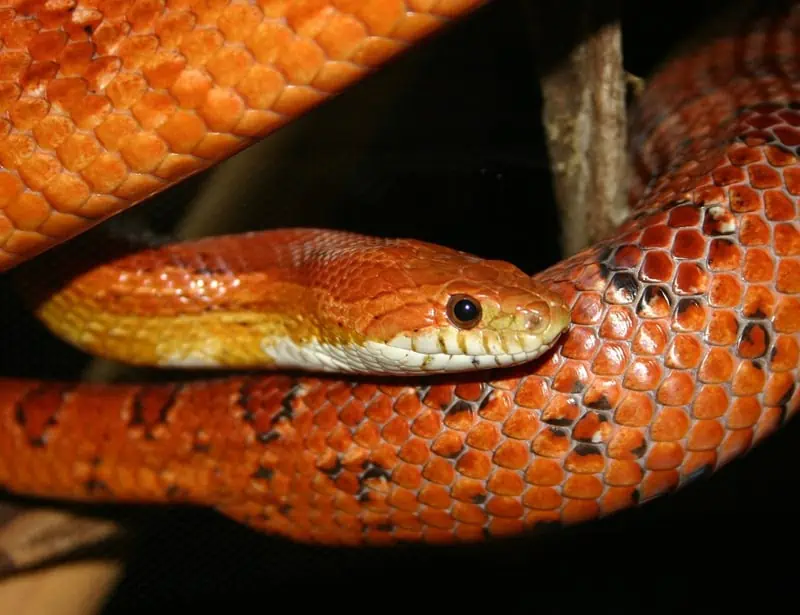
The Corn Snake has a distinctive reddish-orange, brown, and gray pattern resembling kernels of Indian maize. Likewise, black-bordered red splotches on their back and sides contrast sharply against their vibrant colors.
These types of snakes are skilled climbers who often explore the treetops, though they prefer the ground as their natural habitat. They also help balance the ecosystem by controlling potential rodent problems.
Corn Snakes become less active during winter but do not enter a complete dormancy like certain snake species. Like most snake species, they emerge at night but can appear unexpectedly during the daytime if the temperature is cool enough.
Read more: Corn Snake Facts.
8. Cottonmouth (Agkistrodon piscivorus)
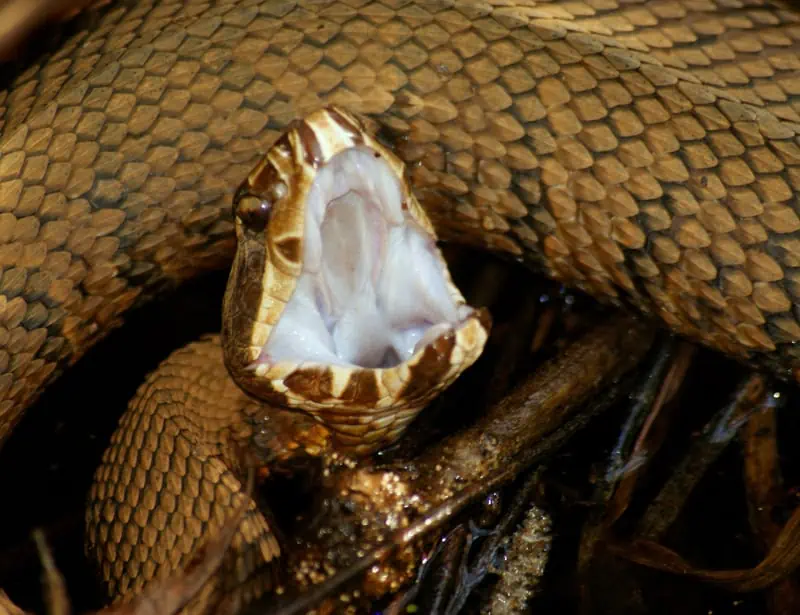
The Cottonmouth is a semi-aquatic venomous snake often found in marshy bogs or near the river's edge, basking in the sun.
Moreover, it is a silent predator that is always on the hunt. Its heat-sensing pits between its eyes and nostrils help guide it to its warm-blooded prey, including rodents, birds, and other snakes.
Male Cottonmouths perform an intricate dance display during the breeding season to attract mates. Moreover, this type of snake is viviparous and gives birth to live young.
In the wild, the Cottonmouth can live up to 15 years; in captivity, this can extend to 24 years.
9. Eastern Diamondback Rattlesnake (Crotalus adamanteus)
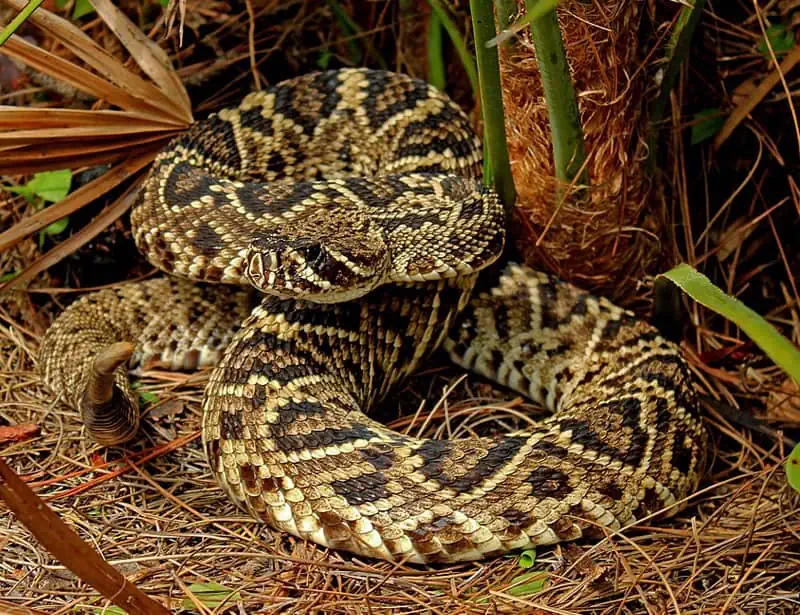
The Eastern Diamondback Rattlesnake is a large venomous snake native to the southeastern region of the United States.
It can grow up to 8 feet long and has a unique zigzagging diamond pattern in bright yellows and earth tones on its back. This colorful pattern warns other animals of its lethal venom. Its dark skin allows it to blend in with fallen leaves and shadows.
The Eastern Diamondback lives in various habitats, from North Carolina to Louisiana, from pine-clad flatwoods coastal scrub habitats to barrier islands.
Despite their menacing appearance, they are not typically aggressive. Besides its prey, the Eastern Diamondback only attacks other animals when the snake feels threatened. Its venom paralyzes its victims and aids in digestion.
Before biting, the snake will shake its rattle, made from the same keratin found in hair and nails, to warn intruders.
Read more: Rattlesnake Facts, Types of Rattlesnake.
10. Emerald Tree Boa (Corallus caninus)
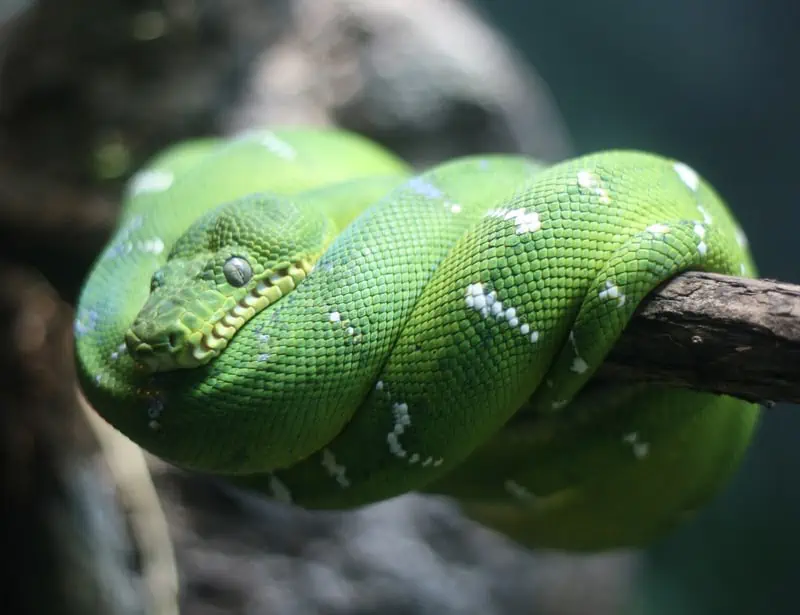
The Emerald Tree Boa lives in the rainforests of South America. Its radiant green scales make it stand out amongst the foliage.
They prefer to reside in treetops, avoiding the busy forest floor. Its emerald coloration allows it to blend in with its surroundings.
Its diet mainly consists of small mammals and birds; the species has honed its hunting skills to become experts at using heat-sense pits to detect warm-blooded prey.
The Emerald Tree Boa also possesses elongated front teeth, which aid in capturing and holding onto their prey. These boas are primarily nocturnal and solitary.
Interestingly, they give birth to live young, covered in reddish-brown scales.
11. Gaboon Viper (Bitis gabonica)
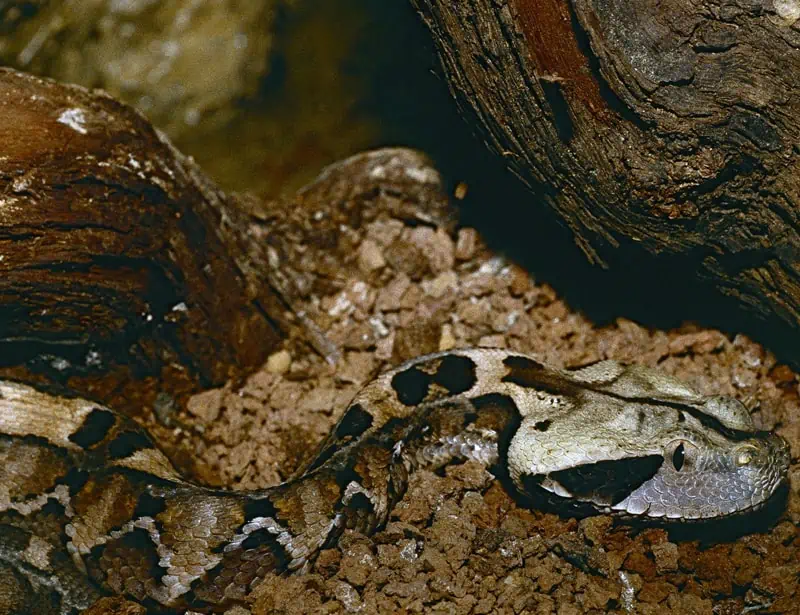
The Gaboon Viper is a venomous snake in Sub-Saharan African rainforests and savannas.
It is one of the heaviest venomous snakes in the region, whose body features diamonds, bands, and spots, allowing it to blend well with the forest floor.
The snake's deceptive appearance often results in the death of small and medium-sized mammals and birds who wander too close.
Moreover, the Gaboon Viper has the longest fangs of any snake species, measuring up to two inches. Its triangular head also has modified scales that resemble horns, adding to its unique appearance.
This snake avoids unnecessary confrontations and prefers to keep a low profile. However, its venom contains potent toxins that can cause significant tissue damage and swelling. Although it is rarely lethal to humans, a bite from this snake can be excruciating.
12. Garter Snake (Thamnophis)
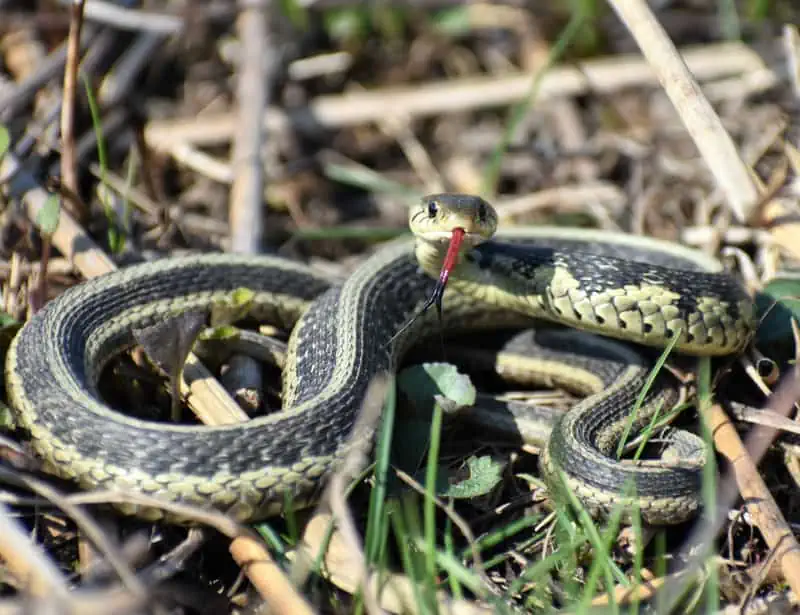
Garter snakes live in North America. To spot this type of snake, look for the stripes along its body, resembling the garters used to hold up stockings.
Moreover, there are approximately 35 different species of garter snakes3, each with its distinct colors and patterns. No two garter snakes are exactly alike.
The harmless garter snakes are moderately sized, ranging from 23 to 30 inches. They live in various landscapes, such as woodlands, meadows, marshlands, and urban areas, where they feed on earthworms, slugs, frogs, fish, and small mammals.
While they pose no danger, a few species of garter snakes produce neurotoxin, which is exceptionally mild.
Unlike most snakes, garter snakes are active during the day and can withstand cold temperatures.
13. King Cobra (Ophiophagus hannah)
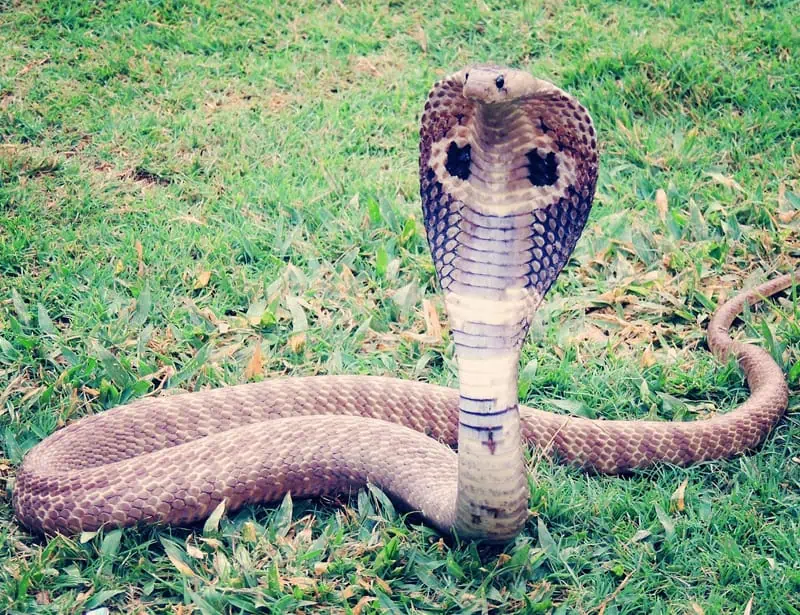
The king Cobra is the world's longest venomous snake, measuring up to 18 feet long.
This creature lives in the forests of India and Southeast Asia, where it lives on the ground and in trees. Its scales range from olive green to deep black, moving fluidly and serenely.
Despite their reputation as dangerous snakes, King Cobras display some surprising behaviors.
Females build nests for their eggs, a behavior typically associated with birds. Their nests provide a secure home for their offspring.
Unlike most venomous snakes, the King Cobra’s venom is so lethal it can kill elephants. Thankfully, this snake does not seek out confrontation. Instead, it flares its hood and lifts a third of its body off the ground, intimidating other animals, striking only as a last resort.
Additionally, the King Cobra eats other snakes, regulating their populations and maintaining the health of its ecosystem.
14. King Snake (Lampropeltis getula)
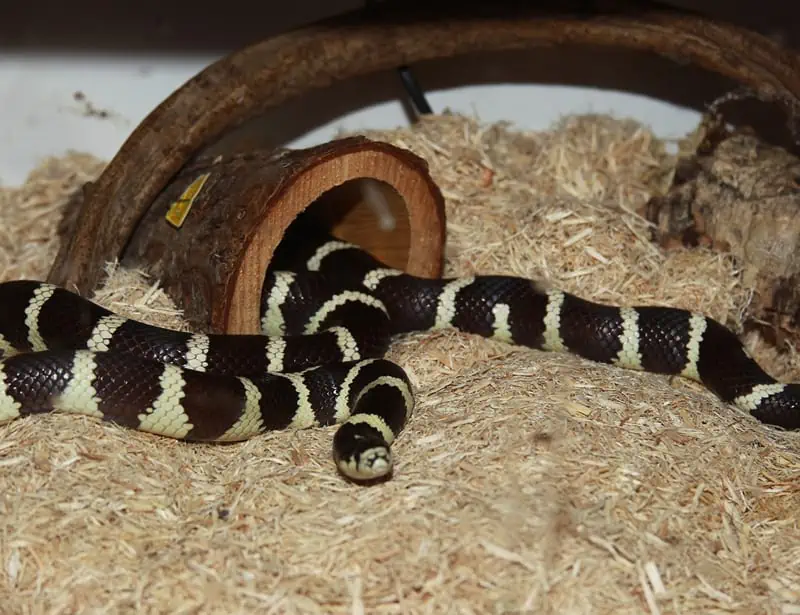
The King Snake lives in North America. Its distinct bands of red, white, and black help it blend in with the shadows and light of the forests and desert.
Surprisingly, the King Snake is not venomous. But, it should not be underestimated.
The King Snake feeds on other snakes; their immunity to venom allows them to eat rattlesnakes, copperheads, and cottonmouths. During feeding, it chokes the life out of its prey.
15. Milk Snake (Lampropeltis triangulum)
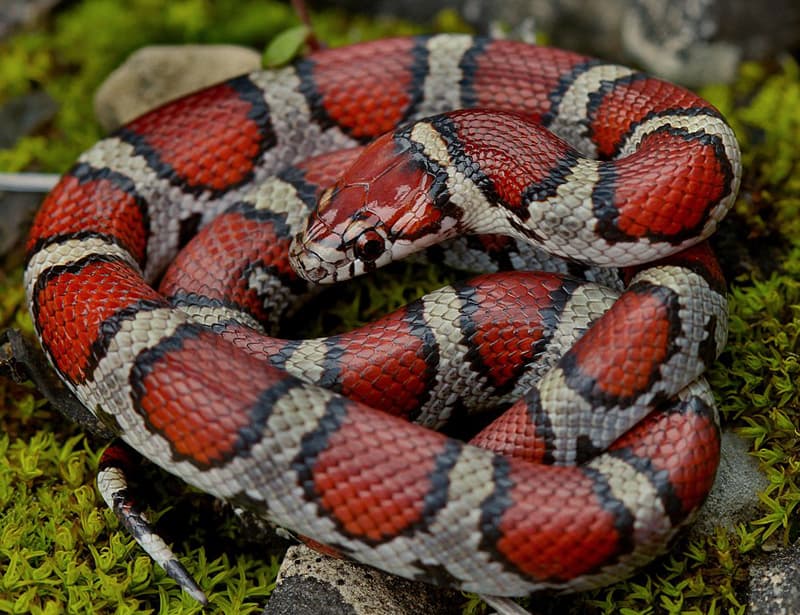
The Milk Snake is a brightly colored species in various landscapes across North and South America. Its distinctive red, white, and black bands often lead to confusion with the venomous Coral Snakes.
Unlike Coral Snakes, Milk Snakes are harmless snakes. These nonvenomous snakes have red and black bands.
The Milk Snake is nocturnal, tending to hide in burrows and shadows during the day. It emerges at night to hunt suffocating prey like rodents, birds, reptiles, and eggs.
This diverse diet, combined with the Milk Snake's adeptness at hiding, allows it to thrive in various environments, including dense forests, open fields, and arid deserts.
Milk Snakes can also vibrate their rattles when threatened. However, we must remember that these snakes are generally peaceful and prefer avoiding humans.
16. Green Tree Python (Morelia viridis)
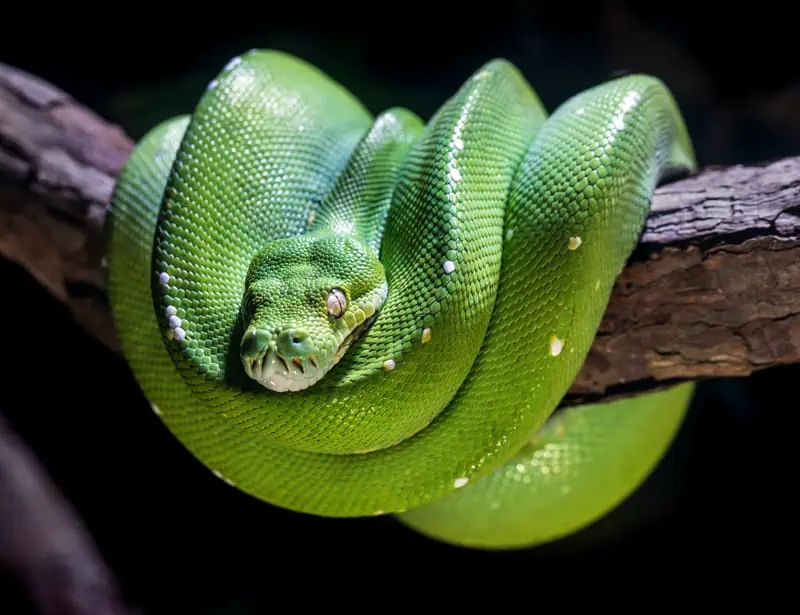
The Green Tree Python lives in the treetops of New Guinea, Indonesia, and the Cape York Peninsula in Australia.
Its green coloration allows it to blend in seamlessly with its leafy surroundings. This species has adapted well to life above ground, with its slender body quickly coiling around tree branches.
Interestingly, Green Tree Pythons change color as they age. When young, they are yellow or red but transform into a vibrant green as they mature.
The Green Tree Python patiently waits for prey to pass before striking. Besides its vision, it has heat-sensing pits on its lips, enabling it to detect warm-blooded prey in the chilly forest environment.
When threatened, the Green Tree Python curls into a tight ball with its head safely tucked within the coil.
17. Coral Snake
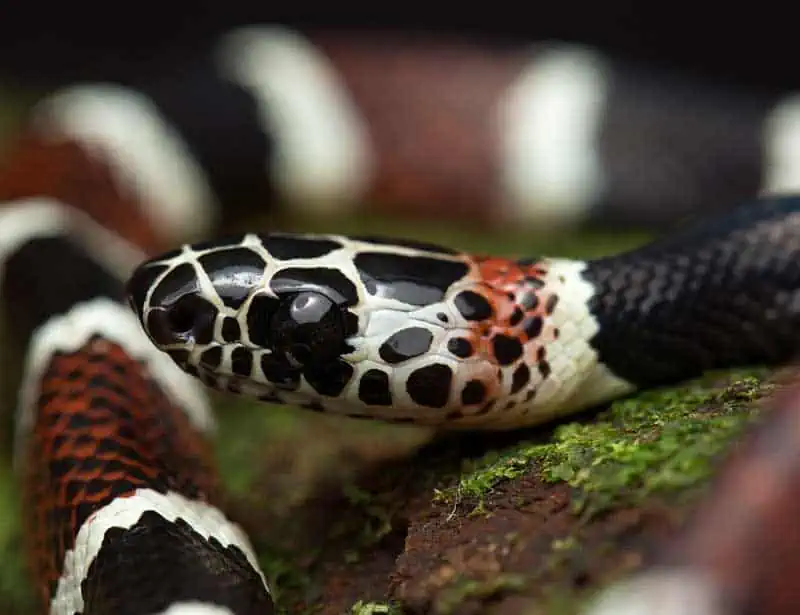
Belonging to the Elapidae family, the coral snake is known for its iconic red, yellow/white, and black banding pattern, which serves as a visual warning to potential predators about its deadly venom.
Coral snakes represent a significant collection of snake species split into two main groups: the Old World coral snakes, found primarily in Asia, and the New World coral snakes, found across the Americas.
In North America, coral snakes are known for their potent neurotoxic snake venom, which targets the nervous system and can result in severe symptoms if not treated promptly. Despite their small size, both the Eastern and Arizona coral snake species, two of the most commonly found coral snake species in America, carry a highly effective venom, yet are rarely a problem for humans, whom they tend to avoid.
Furthermore, these snakes exhibit a fascinating behavior known as "shy biting," where they often hold onto their prey after biting instead of striking and releasing.
Conclusion
In summary, we examined 15 snake species, delving into habitat, physical features, reproduction, predatory behavior, and venom potency. Beyond their variations, snakes play a crucial role in maintaining ecological balance. They manage populations of smaller animals, thus serving as indicators of environmental health.
Despite the fear and misapprehension surrounding these creatures, we must recognize their importance and make concerted efforts to protect their survival for generations to come.
To read more about what people say about snakes, slither over to our snake quotes.
Types of Snake FAQs
The largest snake in the world is the Green Anaconda (Eunectes murinus), which can reach lengths of up to 30 feet and can weigh up to 550 lbs.
Most snake species are non-venomous and pose no threat to humans. Out of the 3,900 snake species, about 600 are venomous snake species, and only 200 can cause human fatalities.
Some snakes, like the Boa Constrictor and the Anaconda, give birth to live young.
Some snakes, like the Ball Python, ambush their prey by staying still and striking when the opportunity arises, while others, like the Black Mamba, actively pursue and inject venom into their prey.
Snakes help control rodent populations and maintain a balance in the food chain. Additionally, their shed skin and droppings contribute to environmental nutrient cycling.
| 1 |
Aubret, F., Bonnet, X., Shine, R., & Maumelat, S. (2003). Clutch size manipulation, hatching success and offspring phenotype in the ball python (Python regius). Biological Journal of the Linnean Society, 78(2), 263-272. |
| 2 |
Reed, R. N., Rodda, G. H., Dorcas, M. E., Snow, R. W., Rochford, M. R., Hardy, D. L., ... & Hart, K. M. (2012). Ecological correlates of invasion impact for Burmese pythons in Florida. Integrative and Comparative Biology, 52(2), 165-175. |
| 3 |
Rossman, D. R., Ford, N. B., & Seigel, R. A. (1996). The Garter Snakes: Evolution and Ecology. University of Oklahoma Press. |
Mike is a degree-qualified researcher and writer passionate about increasing global awareness about climate change and encouraging people to act collectively in resolving these issues.
Fact Checked By:
Isabela Sedano, BEng.

